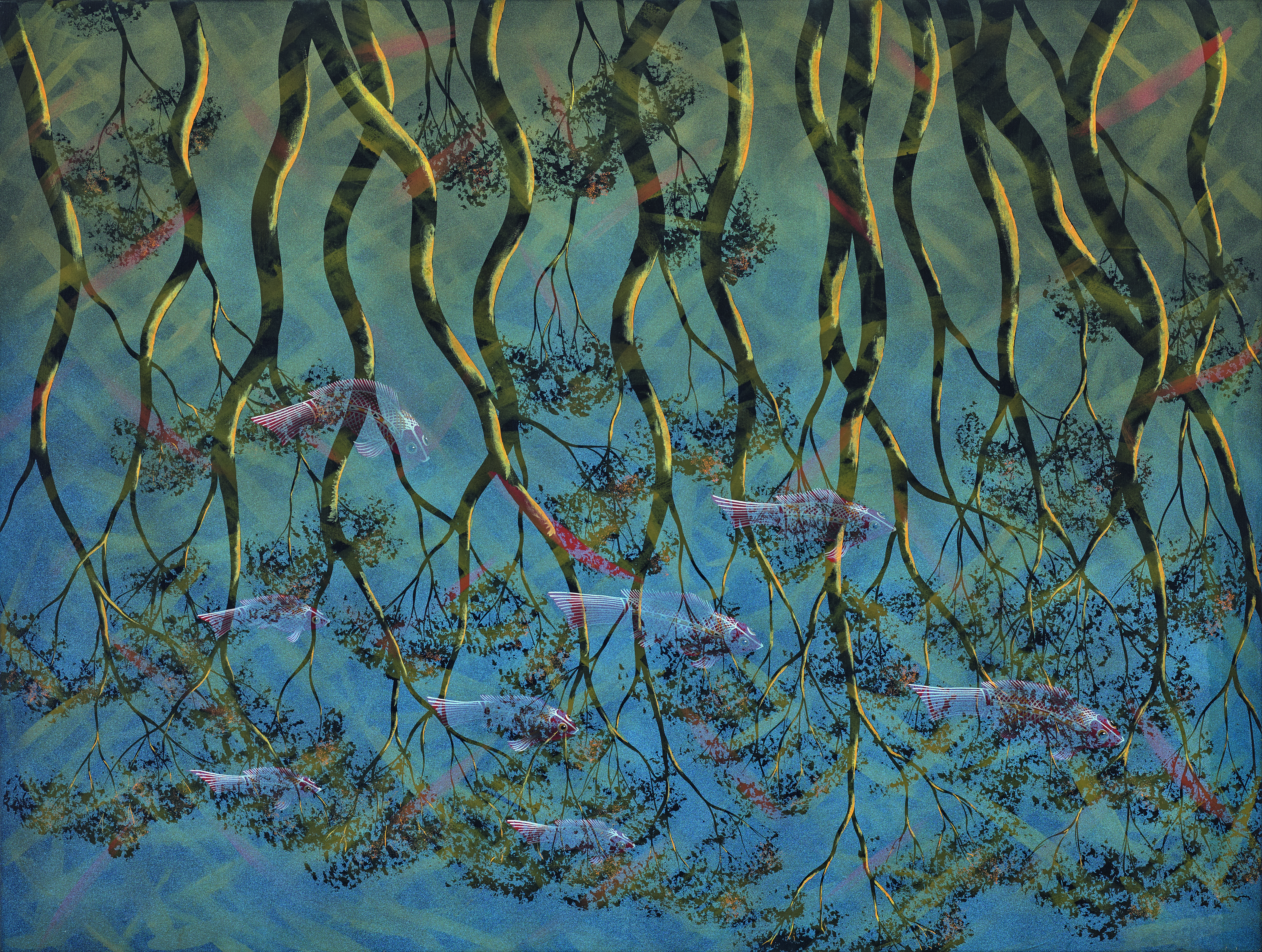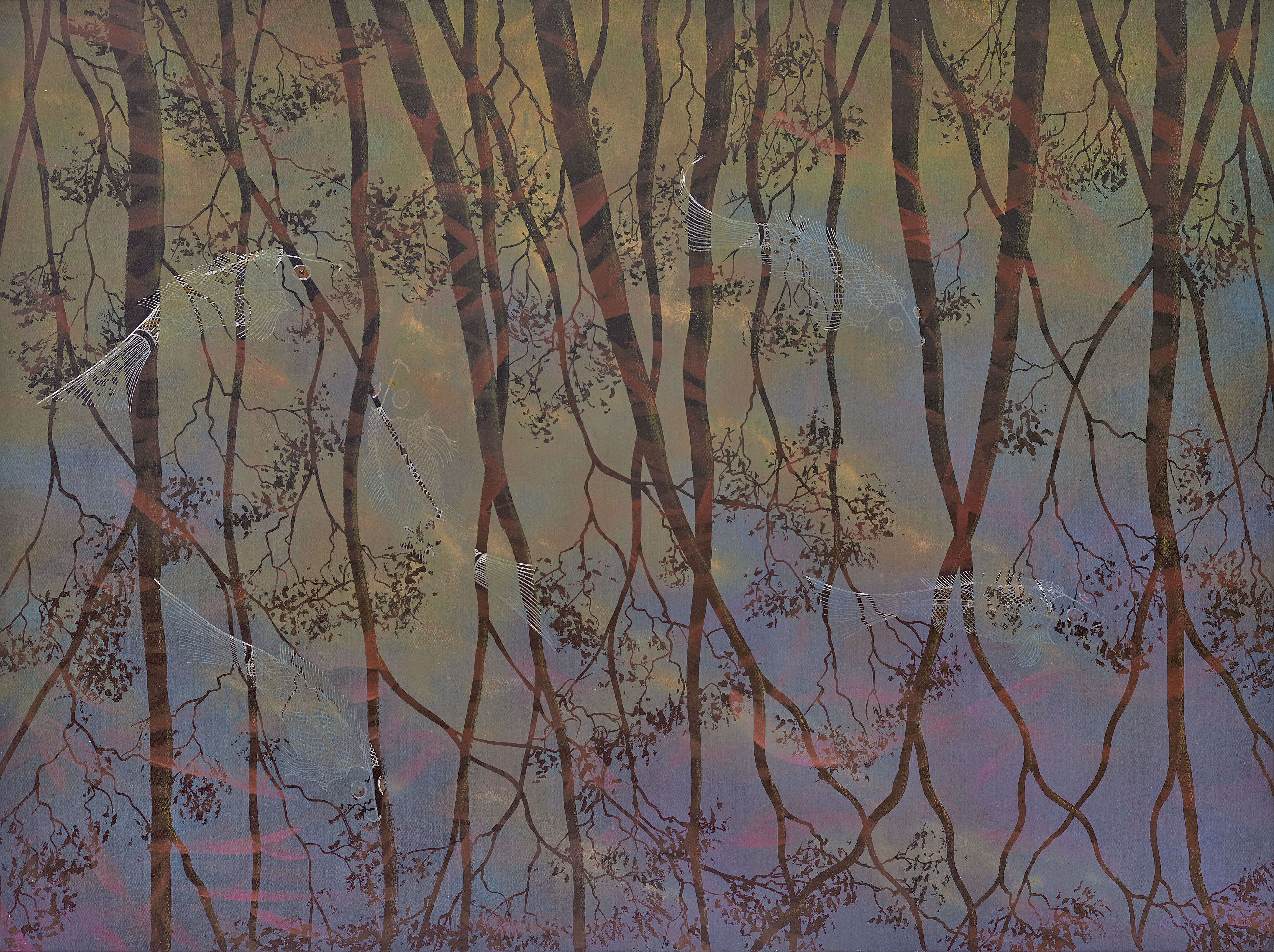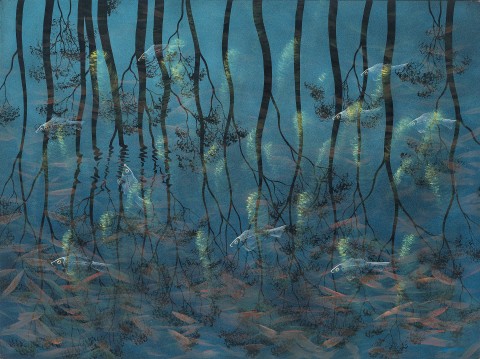LIGHTNING WEED AND RIPPLE, 1996
LIN ONUS
synthetic polymer paint on canvas
91.5 x 122.0 cm
signed lower right: Lin Onus
Estate of the artist, Melbourne
Savill Galleries, Melbourne (label attached verso)
Private collection, Melbourne
Lin Onus, Savill Galleries, Melbourne, 30 October – 23 November 2003, cat. 4 (illus. in exhibition catalogue, p. 4)
dh220916 HRjpg.jpg

Extraordinarily beautiful and technically flawless, the paintings of Lin Onus exhibit a complex mixture of ideas set around place, ownership and history wherein they occupy a distinctive position in the broader setting of Australian art. Paintings such as Lightning Weed and Ripple, 1996 have the capacity to transfix the viewer and are full of meaning, what Michael O’Farrell observed as ‘the sheer tactility of Lin Onus… imagery that establishes a carefully balanced dialogue of sensory and mental elements.’1 Renowned for incorporating satire and humour in his early political installations and paintings that challenged cultural hegemonies, it is in these later paintings that Onus demonstrated his Indigenous connection to country. Poetic landscapes of the natural world combined with subtle traditional iconography confirmed Onus’ relationship to both his adopted homeland in Arnhem Land and to his own ancestral sites at the Barmah Forest on the Murray River.
Growing up in a culturally productive and politically engaged household in Melbourne, Onus could not help but be influenced by the activism of his family. His mother Mary Kelly was of Scottish origin and an active member of the Australian communist party and his father, Bill Onus, a Yorta Yorta man from the Aboriginal mission of Cummeragunja near Echuca, was an important figure in the Aboriginal civil rights movement, whose Aboriginal Enterprises (1952 – 1968) provided an outlet for Aboriginal art and craft in defiance of the then-national goal of assimilation. In 1957, Bill Onus together with Doug Nicholls established the Aboriginal Advancement League in Victoria with a goal to ‘promote cultural renewal and reawaken aboriginal pride.’2 Onus’ cultural education on his Aboriginal side was provided by visits to Cummeragunja with his father. There they would sit with his uncle Aaron Briggs (who gave Onus his Koori name, Burrinja, meaning ‘star’3), on the banks of the Murray River within view of the Barmah Forest (Onus’ spiritual home and the subject of many of his paintings), listening to stories of family and history. Leaving school at 14, Lin Onus began, his largely self-taught, artistic career assisting his father in decorating artefacts. After embarking on a panel-beating apprenticeship, he developed skills working on metal and painting with an airbrush. By 1974, he was painting watercolours and photorealist landscapes and in 1975, he held his first exhibition and began a set of paintings based on Musqito, the first Aboriginal guerrilla fighter, which still hang on the walls of the Advancement League in Melbourne.
dh200289 Lin Onus HR.jpg

While the bullying and racism experienced by Onus in suburban Melbourne during the 1960s influenced much of his art, the cultural revelations that came from his friendship with respected Arnhem Land artist Jack Wunuwun (1930 – 1991) enabled Onus to embrace both his Indigenous and non-Indigenous heritage. From his first encounter with Wunuwun at Maningrida in 1986 while travelling in his role as the Victorian representative for the Aboriginal Arts Board, Onus’ life was deeply influenced by the late Yolŋu Elder, who had adopted Onus as his son. Over the next decade, Onus made sixteen ‘spiritual pilgrimages’ to the outstation of Garmedi, the home of Jack Wunuwun in Central Arnhem land.4 Wunuwun was able to offer Onus a kind of cultural sanctuary by welcoming him into the Yolŋu kinship system – a relationship that provided Onus with the opportunity to learn Aboriginal traditional knowledge which enhanced his own Yorta Yorta experience of the world. Through Wunuwun, Onus was given creation stories that he was permitted to paint and an Aboriginal language he could also access. As Onus noted, ‘…going to Arnhem Land gave him back all the stuff that colonialism had taken away – Language and Ceremony.’5 Onus acquired his knowledge of symbols, patterns and designs from the community elders, and it seemed to him that this experience of tradition was ‘like a missing piece’ of a puzzle which ‘clicked into position’ for him culturally.6 His resulting personal idiom thus juxtaposed the rarrk clan patterns of Maningrida, learnt from the older artist, with a photorealist style of landscape, integrating Indigenous spirituality and narrative with Western representation.
Lightning Weed and Ripple, 1996 presents a mesmerising, immaculately executed image of central Arnhem Land wetlands where the surrounding tall trees are reflected in the cool dark water of the billabong and fish glide just below the surface of the water, creating ripples and affording glimpses of the traditional markings that cover their bodies. Onus’ watery landscapes embrace what Wunuwun described as ‘seeing below the surface’7 and function on several levels. Rich in reflections and ambiguities, these enigmatic views clearly dispensed with the conventional idea of a European panoramic view. Here a landscape apparently hangs upside down from the sky. Reflected in the still water, flashes of lightning expose the serpentine tree branches and illuminate the leaf detritus below, while the school of rarrk-covered fish swim not only under the water, but seemingly through the sky and the branches of the trees as well. As Margot Neale elaborates, these paintings are ‘deceptively picturesque, for things are not always what they seem. Laden with cross-cultural references, visual deceits, totemic relationships and a sense of displacement, they, amongst other things, challenge one’s viewing position: Are you looking up through water towards the sky, down into a waterhole from above, across the surface only or all three positions simultaneously?’8
Reflections are essential to the art of Lin Onus, literally and metaphorically, and both his painting and his social activism address issues of identity, racism and the power imbalance between Indigenous and non-Indigenous Australians. Indeed, throughout his lifetime Onus held a mirror to unresolved social inequality within this country and explored what it means to be Australian, with his luminous paintings reflecting his desire to create an art that could be appreciated on numerous levels by everyone. Onus hoped that ‘history would see him as some sort of bridge between cultures’9 and as articulated by Ian Mclean, ‘[he] successfully used postmodern strategies to infiltrate issues of Aboriginality into everyday Australian life.’10 This convergence of different cultures, languages and visual perspectives thus powerfully embodies both Onus’ personal and artistic journey, and it is appropriate that through his prodigious talent and legacy of widely celebrated work he ultimately did succeed in bringing together Indigenous and non-Indigenous perspectives in a spirit of reconciliation that celebrates the intersection of differing values and points of view.
1. O’Ferrall, M., ‘Lin Onus’ in Australian Perspecta 1991, Art Gallery of New South Wales, Sydney, 1991, p. 80
2. Kleinert, S., ‘Aboriginal Enterprises: negotiating an urban Aboriginality’, Aboriginal History, vol. 34, 2010, see: http://press-files.anu.edu.au/downloads/press/p170581/html/ch07.xhtml?re... (accessed 20 October 2024)
3. Neale, M., Urban Dingo: The Art of Lin Onus 1948 – 1996, Queensland Art Gallery, Brisbane, 2000, p. 14
4. ibid., p. 15
5. ibid.
6. Leslie, D., ‘Coming home to the land’, Eureka Street, March – April 2006, see: https://www.eurekastreet.com.au/article/coming-home-to-the-land# (accessed 20 October 2024)
7. Neale, M. et al., Lin Onus: A Cultural Mechanic, Savill Galleries, Melbourne, 2003, p. 1
8. ibid.
9. Neale, 2000, op. cit., p. 21
10. ibid., p. 41
CRISPIN GUTTERIDGE

